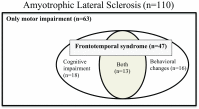The frontotemporal syndrome of ALS is associated with poor survival
- PMID: 27671483
- PMCID: PMC5110703
- DOI: 10.1007/s00415-016-8290-1
The frontotemporal syndrome of ALS is associated with poor survival
Abstract
Thirty percent of ALS patients have a frontotemporal syndrome (FS), defined as behavioral changes or cognitive impairment. Despite previous studies, there are no firm conclusions on the effect of the FS on survival and the use of non-invasive ventilation (NIV) in ALS. We examined the effect of the FS on survival and the start and duration of NIV in ALS. Behavioral changes were defined as >22 points on the ALS-Frontotemporal-Dementia-Questionnaire or ≥3 points on ≥2 items of the Neuropsychiatric Inventory. Cognitive impairment was defined as below the fifth percentile on ≥2 tests of executive function, memory or language. Classic ALS was defined as ALS without the frontotemporal syndrome. We performed survival analyses from symptom onset and time from NIV initiation, respectively, to death. The impact of the explanatory variables on survival and NIV initiation were examined using Cox proportional hazards models. We included 110 ALS patients (76 men) with a mean age of 62 years. Median survival time was 4.3 years (95 % CI 3.53-5.13). Forty-seven patients (43 %) had an FS. Factors associated with shorter survival were FS, bulbar onset, older age at onset, short time to diagnosis and a C9orf72 repeat expansion. The adjusted hazard ratio (HR) for the FS was 2.29 (95 % CI 1.44-3.65, p < 0.001) in a multivariate model. Patients with an FS had a shorter survival after NIV initiation (adjusted HR 2.70, 95 % CI 1.04-4.67, p = 0.04). In conclusion, there is an association between the frontotemporal syndrome and poor survival in ALS, which remains present after initiation of NIV.
Keywords: Amyotrophic lateral sclerosis; Behavioral changes; Cognitive impairment; Frontotemporal syndrome; Non-invasive ventilation; Survival.
Conflict of interest statement
Compliance with ethical standards Conflicts of interest The authors report no disclosures. Ethical standards The study was approved by the medical ethical committees of the hospitals and was performed in accordance with the ethical standards laid down in the 1964 Declaration of Helsinki and its later amendments. Informed consent Written informed consent was obtained from all participants at inclusion.
Figures



Similar articles
-
Is survival improved by the use of NIV and PEG in amyotrophic lateral sclerosis (ALS)? A post-mortem study of 80 ALS patients.PLoS One. 2017 May 23;12(5):e0177555. doi: 10.1371/journal.pone.0177555. eCollection 2017. PLoS One. 2017. PMID: 28542233 Free PMC article.
-
Neurobehavioral features in frontotemporal dementia with amyotrophic lateral sclerosis.Arch Neurol. 2010 Jul;67(7):826-30. doi: 10.1001/archneurol.2010.146. Arch Neurol. 2010. PMID: 20625088
-
[Genetic coherence between hereditary amyotrophic lateral sclerosis and frontotemporal dementia].Tidsskr Nor Laegeforen. 2014 Feb 11;134(3):302-6. doi: 10.4045/tidsskr.13.0049. Tidsskr Nor Laegeforen. 2014. PMID: 24518478 Review. Norwegian.
-
Cerebellar c9RAN proteins associate with clinical and neuropathological characteristics of C9ORF72 repeat expansion carriers.Acta Neuropathol. 2015 Oct;130(4):559-73. doi: 10.1007/s00401-015-1474-4. Epub 2015 Sep 8. Acta Neuropathol. 2015. PMID: 26350237 Free PMC article.
-
Frontotemporal Dysfunction and Dementia in Amyotrophic Lateral Sclerosis.Neurol Clin. 2015 Nov;33(4):787-805. doi: 10.1016/j.ncl.2015.07.011. Epub 2015 Sep 8. Neurol Clin. 2015. PMID: 26515622 Review.
Cited by
-
Palliative care in motor neurone disease: where are we now?Palliat Care. 2019 Jan 21;12:1178224218813914. doi: 10.1177/1178224218813914. eCollection 2019. Palliat Care. 2019. PMID: 30718958 Free PMC article. Review.
-
The C9orf72 expansion is associated with accelerated respiratory function decline in a large Amyotrophic Lateral Sclerosis cohort.HRB Open Res. 2019 Sep 26;2:23. doi: 10.12688/hrbopenres.12940.1. eCollection 2019. HRB Open Res. 2019. PMID: 32296747 Free PMC article.
-
Highlights from the Respiratory Failure and Mechanical Ventilation Conference 2024.Breathe (Sheff). 2024 Nov 12;20(3):240105. doi: 10.1183/20734735.0105-2024. eCollection 2024 Oct. Breathe (Sheff). 2024. PMID: 39534488 Free PMC article.
-
Study on the Diagnostic Value of Neuroelectrophysiological Examination in Patients with Amyotrophic Lateral Sclerosis.Comput Math Methods Med. 2022 Oct 12;2022:3907751. doi: 10.1155/2022/3907751. eCollection 2022. Comput Math Methods Med. 2022. Retraction in: Comput Math Methods Med. 2023 Nov 29;2023:9858143. doi: 10.1155/2023/9858143. PMID: 36276994 Free PMC article. Retracted. Clinical Trial.
-
TMEM106B Acts as a Modifier of Cognitive and Motor Functions in Amyotrophic Lateral Sclerosis.Int J Mol Sci. 2022 Aug 17;23(16):9276. doi: 10.3390/ijms23169276. Int J Mol Sci. 2022. PMID: 36012536 Free PMC article.
References
-
- Brooks BR, Miller RG, Swash M, Munsat TL. El Escorial revisited: revised criteria for the diagnosis of amyotrophic lateral sclerosis. Amyotroph Later Scler. 2000;1:293–299. - PubMed
MeSH terms
Substances
LinkOut - more resources
Full Text Sources
Other Literature Sources
Medical
Miscellaneous

